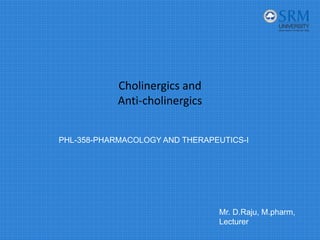Cholinergics.pdf
- 1. Cholinergics and Anti‐cholinergics PHL-358-PHARMACOLOGY AND THERAPEUTICS-I Mr. D.Raju, M.pharm, Lecturer
- 2. Cholinergic Drugs • Parasympathomimetics or cholinomimetics • Stimulate parasympathetic nervous system in same manner as does acetylcholine • May stimulate cholinergic receptors directly or slow acetylcholine metabolism at synapses (affect the enzyme acetylcholinesterase)
- 5. Cholinergic Drugs • Acetylcholine important neurotransmitter affecting cognitive functioning, memory storage and retrieval • In Alzheimer’s disease (AD), abnormalities of the cholinergic, serotonergic, noradrenergic, and glutaminergic neurotransmission systems • In cholinergic system, patient with AD found to have loss of neurons that secrete acetylcholine
- 6. Cholinergic Drugs—GI effects • Acetylcholine stimulates cholinergic receptors in the gut to promote normal secretory and motor activity • Cholinergic activity in the gut will increase peristalsis and facilitates movement of flatus and feces • The secretory functions of the salivary and gastric glands also stimulated
- 8. Acetylcholine • One of the main neurotransmitters of the ANS is acetylcholine • Acetylcholine is released at preganglionic fibers of both the sympathetic and parasympathetic nervous system • Also released from postganglionic sympathetic neurons that innervate the sweat glands and from motor neurons that innervate the skeletal muscles
- 12. Mechanisms of Action— Direct Acting Cholinergics • Direct acting cholinergics are lipid insoluble • Do not readily enter the CNS so effects are peripheral • Resistant to metabolism by acetylcholinesterase • Effects are longer acting than with acetylcholine
- 14. Direct‐acting Cholinergic Drugs Effects • Decreased heart rate, vasodilation, variable BP effects • Increased tone and contractility in GI smooth muscle, relaxation of sphincters, increased salivary gland and GI secretions • Increased tone and contractility of smooth muscle in urinary bladder and relaxation of the sphincter
- 15. Direct Acting Cholinergic Drugs cont. • Increased tone and contractility of bronchial smooth muscle • Increased respiratory secretions • Constriction of pupils (miosis) and contraction of ciliary muscle
- 19. Indirect‐acting agents cont. • Neostigmine (Prostigmine)—prototype anticholinesterase agent. Used for long‐term tx of myasthenia gravis and as an antidote for tubocurarine and other non‐depolarizing agents in surgery. • Poorly absorbed orally so requires larger doses than when given parenterally. • Can develop resistance to its action over time
- 22. Indirect Acting Agents used to treat Alzheimer’s disease • Donepezil (Aricept)—said to delay progression of the disease by up to 55 weeks. Does not cause liver toxicity. • Galantamine (Reminyl)—newest kid on the block • Rivastigmine (Exelon) long acting. Twice a day dosing. • Tacrine (Cognex)—hepatoxic. Elevated liver enzymes usu. Within 18 wks. > in women.
- 23. Specific Conditions • Distinction between cholinergic crisis and a myasthenic crisis • Difficult to ascertain as both are characterized by respiratory difficulty or failure • Need to distinguish as require opposite treatment measures
- 24. Specific Conditions—Cholinergic vs. Myasthenic Crisis • Myasthenic crisis requires more anticholinesterase drug whereas cholinergic crisis requires discontinuation of the anticholinesterase drugs • Diagnosis can be made by evaluating patient patient response to their medication (s/s one hour after medication often is cholinergic crisis, s/s 3 or more hours after medication often is myasthenic crisis
- 26. Toxicity of Cholinergic Drugs • Atropine is the specific antidote to cholinergic agents • Atropine reverses only the muscarinic effects of cholinergic drugs; heart, smooth muscle, and glands. • Atropine cannot reverse the nicotinic effects of skeletal muscle weakness or paralysis due to overdose of indirect cholinergic drugs.
- 27. Toxicity of Irreversible Anticholinesterase Agents • These agents are lipid soluble • Can enter the body by the eye,skin, respiratory system and GI tract. • Case in point, organophosphate insecticides (malathion, parathion) or nerve gases (sarin, tabun, soman) • These agents cause excessive cholinergic stimulation (muscarinic) and neuromuscular blockade
- 28. Anticholinergics • Also called cholinergic blocking agents or parasympatholytics • Again, focus is on the parasympathetic nervous system • Parasympathetic system acts as a resting and reparative function • Functions include digestion, excretion, cardiac decelertion, anabolism and near vision
- 33. Effects on Body Tissues 1. CNS stimulation followed by depression, can result in coma and death (atropine, antiparkinson’s) 2. Decreased cardiovascular response to vagal stimulation resulting in tachycardia. Increases vagal tone. Ex. Atropine. 3. Bronchodilation and decreased respiratory tract secretions.
- 34. Effects on Body Tissues • Antispasmotics of GI tract due to decreased tone and motility. • Mydriasis and cyclopegia. Normally do not increase IOP but caution as can precipitate acute glaucoma. • Can cause decreased oral secretions, decreased sweating, relaxation of urinary bladder
- 37. Use in GU disorders • Antispasmotic effects seen in overactive bladder and in urinary incontinence
- 40. Cardiology • Atropine is used to increase heart rate in symptomatic bradycardias and higher blocks
- 41. Parkinson’s Disease • Useful in those with minimal side effects • Those who cannot take Levodopa • Helpful in decreasing salivation, spasticity and tremors
- 43. Contraindications • BPH • Myasthenia gravis • Hyperthyroidism • Glaucoma • Tachydysrhythmias • Not in situations whereby delaying of gastric emptying is a concern
- 44. Individual Anticholinergic Drugs • Atropine—prototype. Antidote. Belladonna alkaloid. • Ipratropium (Atrovent). Useful in rhinorrhea. Also excellent bronchodilator. • Scopolamine, similar to atropine. Depresses CNS and causes amnesia, drowsiness, euphoria, relaxation and sleep. Also good for motion sickness. Given parenterally, orally and transdermally.
- 46. Urinary Antispasmotics • Flavoxate (Urispas)—relieves dysuria, urgency, frequency, and pain with GU infections • Oxybutynin (Ditropan) has direct antispasmodic effects on smooth muscle and anticholinergic effects. Decreases frequency of voiding. • Tolterodine (Detrol) is competitive, antimuscuranic anticholinergic that inhibits contraction. More selective for this area than elsewhere in the body.
